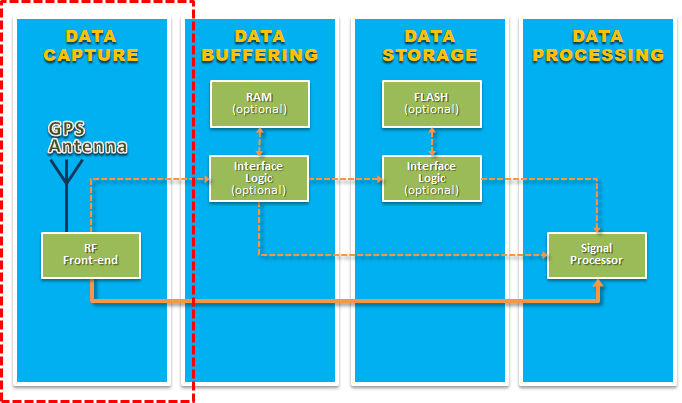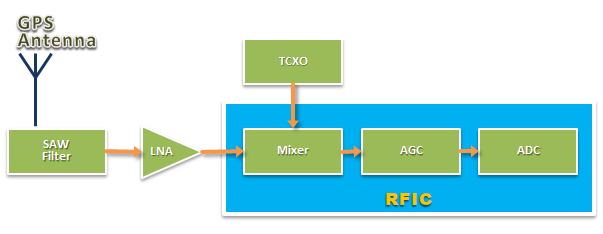What is Snapshot Positioning? (Part 2 – Data Capture module)
In the previous blog post, I explained what a #SnapshotReceiver is. If it all seems distant or sketchy, you can review it here.
A typical snapshot receiver consists of four discrete modules:
- Data Capture
- Data Buffering
- Data Storage
- Data Processing

Conceptually, the Data Capture module is responsible for capturing the #GPS signals transmitted from the satellites and then digitizes it for the Signal Processor to compute a position.
Essentially, the Data Capture module consists of:
- An antenna that captures the analog GPS satellite signals and
- A RF (Radio Frequency) Front-end that converts the signals into digital IF data format.
Bear in mind that the GPS signals transmitted by the satellite is in the L1 frequency band – 1574.42 MHz. The RF circuitry for a front-end is usually quite complex because it has to convert the high frequency radio signals at the 1.5 GHz level down to a few MHz that is suitable for digital signal processing. In addition, to minimize cost, physical size and power consumption, the RF Front-end is usually implemented in an integrated circuit which is sometimes referred to as an #RFIC – Radio Frequency Integrated Circuit.
A typical RF Front-end consists of the following:
- Antenna
- SAW (Surface Acoustic Wave) filter
- LNA (Low-Noise Amplifier)
- TCXO (Temperature Compensated Crystal Oscillator)
- Mixer
- AGC (Automatic Gain Control)
- ADC (Analog to Digital Converter)

While there are many RFIC products that can be purchased off-the-shelf, in principle, Snapshot Receiver can be made compatible with any RFIC. In choosing an RFIC for #UltraLowPowerGPS projects, it should comply with a few technical specifications such as sampling rate, I & Q bit format, physical size and low power consumption, etc. For applications that demand reliability and versatility, the de facto industry standard is the MAX2769 RFIC from Maxim Integrated.
The MAX2769 is a single-conversion, low-IF GNSS receiver that is designed for high performance consumer applications. The MAX2769 is based on Maxim’s advanced low-power SiGe BiCMOS process technology and it incorporates a complete receiver chain including a dual-input LNA and mixer, followed by the image-rejected filter, Programmable Gain Amplifier (PGA), Voltage-Controlled Oscillator (VCO), fractional-N frequency synthesizer, crystal oscillator, and a multibit ADC. The total cascaded noise figure of this receiver is as low as 1.4 dB.

For most #Wearables and #IoT applications, the MAX2769 is ideal because it is housed in a compact 5 X 5 mm, 28-pin thin QFN package. For those that are interested in high volume applications, the MAX2769 is also available in die form.
In this blog post, we have discussed the Data Capture module of a snapshot receiver and also, briefly touched upon a few RF terminologies as seen above. In practice, implementing the Data Capture module is actually as simple as wiring up an RFIC.
In the next blog post, I will be discussing the Data Buffering and the Data Storage modules in more detail. I hope to see you then!